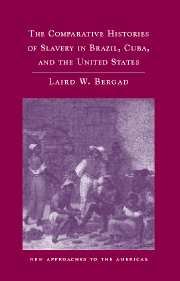Book contents
- Frontmatter
- Contents
- List of Maps and Figures
- Introduction
- 1 From Colonization to Abolition: Patterns of Historical Development in Brazil, Cuba, and the United States
- 2 The Diversity of Slavery in the Americas to 1790
- 3 Slaves in Their Own Words
- 4 Slave Populations
- 5 Economic Aspects
- 6 Making Space
- 7 Resistance and Rebellions
- 8 Abolition
- Bibliography
- Index
- Plate section
4 - Slave Populations
Published online by Cambridge University Press: 05 June 2012
- Frontmatter
- Contents
- List of Maps and Figures
- Introduction
- 1 From Colonization to Abolition: Patterns of Historical Development in Brazil, Cuba, and the United States
- 2 The Diversity of Slavery in the Americas to 1790
- 3 Slaves in Their Own Words
- 4 Slave Populations
- 5 Economic Aspects
- 6 Making Space
- 7 Resistance and Rebellions
- 8 Abolition
- Bibliography
- Index
- Plate section
Summary
Historians of slavery in the Western Hemisphere have long recognized the unique characteristics of slavery in the United States. Among the major American slave societies it was the only large-scale slave system in which the slave population grew in extraordinary numbers through natural reproduction. Every other slave society in the Western Hemisphere relied on the transatlantic slave trade to increase the availability of slave labor, since slave populations did not experience net reproduction on their own. General statistical data clearly illustrate this.
Before the slave trade to the United States was curtailed in 1808, it has been estimated that approximately 360,000 slaves were imported to the United States, a figure representing less than 4 percent of the total volume of the slave trade to the Americas. Prior to the outbreak of the Civil War in the United States, the 1860 national census indicated that the slave population stood at nearly four million, more than ten times more slaves than had been imported from Africa. By way of contrast, nearly four million African slaves were imported to Brazil before the slave trade there was halted in the early 1850s, which represents nearly 40 percent of all slaves forced to cross the Atlantic and more than ten times the number of slaves sent to the United States. Yet the 1872 Brazilian national census enumerated approximately 1.5 million slaves, 38 percent of the imported total; and by the final abolition of slavery there in 1888, the slave population had fallen to about 720,000.
- Type
- Chapter
- Information
- Publisher: Cambridge University PressPrint publication year: 2007



